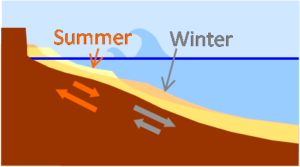 Working with Ole Madsen at MIT, my doctoral research focused on the prediction of cross-shore sediment transport in the nearshore region, a key problem in coastal engineering to understand beach profile evolution. I combined analytical and numerical modeling of the turbulent boundary layer under nearshore waves. By means of an assumption about the turbulence structure, I obtained an analytical characterization of the wave-current turbulent boundary layer hydrodynamics, which I used to successfully predict sediment transport due to nearshore waves and currents. In this study I also characterized key differences between the boundary-layer hydrodynamics of oscillating water tunnels (a laboratory facility commonly used in coastal engineering) and those of real sea waves. I showed that such hydrodynamic differences have a significant effect on the resulting sediment transport, an important result to be accounted for when extrapolating experimental measurements from oscillating water tunnels to field conditions.
Working with Ole Madsen at MIT, my doctoral research focused on the prediction of cross-shore sediment transport in the nearshore region, a key problem in coastal engineering to understand beach profile evolution. I combined analytical and numerical modeling of the turbulent boundary layer under nearshore waves. By means of an assumption about the turbulence structure, I obtained an analytical characterization of the wave-current turbulent boundary layer hydrodynamics, which I used to successfully predict sediment transport due to nearshore waves and currents. In this study I also characterized key differences between the boundary-layer hydrodynamics of oscillating water tunnels (a laboratory facility commonly used in coastal engineering) and those of real sea waves. I showed that such hydrodynamic differences have a significant effect on the resulting sediment transport, an important result to be accounted for when extrapolating experimental measurements from oscillating water tunnels to field conditions.